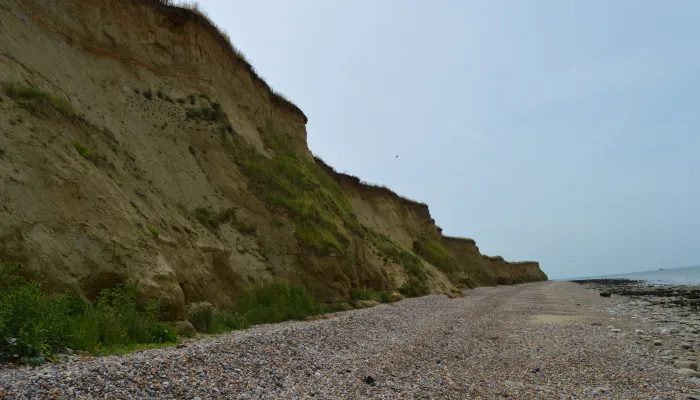Discover the geological materials used in buildings and shore defences around Reculver and examine a classic coastal cliff section.
About the event
On this Geology of Reculver Country Park course we shall be looking at local buildings and shore defences and consider the choice of geological materials used before examining in detail a classic coastal cliff section.
The plan for the day is:
Morning Session
The rocks that make up our landscape are often difficult to see because they are buried below ground. A good place to see the local geology is often in man-made structures made of stone. The morning will be devoted to looking at a range of constructions and learning how to decipher what stone they are made from and where the stones may have been quarried and how they have been transported.
We shall look at a modern monument, a Roman fort, a medieval church and some of the large rocks used to defend our shore line. By looking closely at a selection of building stones we will consider the environment in which each rock formed many millions of years ago. This should enable you to look at stone buildings in your own town with a more considered eye. We shall also discuss the historical contexts of the buildings in regard to the different building materials used and how and why the coastline at Reculver has changed over the last two thousand years.
We will have lunch at Reculver where there is a public house and a café and a coffee shop that are all usually open (check the internet, if necessary, before leaving home). You may prefer to bring a packed lunch, as there is outside seating available.
Afternoon session
We shall drive a short distance (2 kms) along the coast to the cliff section to be studied. Instructions for where to meet will be provided.
Here we shall walk a short distance along the coast at Beltinge and Bishopstone to interpret the various strata we see in the cliff section and understand the dynamic relationship between the sediments and man’s attempts to control this stretch of coastline.
We shall also consider what is a sediment to a geologist and examine a modern analogue to better understand those seen in the cliffs. On the foreshore we shall meet a wide range of geological materials including igneous, metamorphic and sedimentary rocks and we shall look at several of these blocks closely to understand what they can tell us about basic geological principles.
Finally, the cliffs at Beltinge have become a classic location for understanding landslips in a coastal environment. We shall look at aspects of landslip history along this coast, consider how a landslip develops aiding coastal retreat. To counter this loss of land man has emplaced numerous safeguards along this coast; we shall identify these measures and consider their effectiveness.
By the end of the course you should:
- Understand why certain stone types were used by man in different historical contexts.
- Appreciate the range of natural processes that can operate on a short stretch of coastline.
- Understand how we can infer past environments from the evidence of the geological record in the cliff section.
This course is suitable for beginners.
Led by Geoff Downer, Geologist. Geoff is a local geologist who has led field trips, given talks and taught geology to adults for over 20 years.
-
Picnic area
Partially accessible
There is walking over uneven ground and in one place, at the end of the day, a moderately steep path to ascend which can be taken at each individual’s pace. In total the walking distance is no more than 2.5kms.

